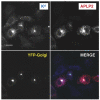Specificity of amyloid precursor-like protein 2 interactions with MHC class I molecules
- PMID: 18452037
- PMCID: PMC2683759
- DOI: 10.1007/s00251-008-0296-0
Specificity of amyloid precursor-like protein 2 interactions with MHC class I molecules
Abstract
The ubiquitously expressed amyloid precursor-like protein 2 (APLP2) has been previously found to regulate cell surface expression of the major histocompatibility complex (MHC) class I molecule K(d) and bind strongly to K(d). In the study reported here, we demonstrated that APLP2 binds, in varied degrees, to several other mouse MHC class I allotypes and that the ability of APLP2 to affect cell surface expression of an MHC class I molecule is not limited to K(d). L(d), like K(d), was found associated with APLP2 in the Golgi, but K(d) was also associated with APLP2 within intracellular vesicular structures. We also investigated the effect of beta(2)m on APLP2/MHC interaction and found that human beta(2)m transfection increased the association of APLP2 with mouse MHC class I molecules, likely by affecting H2 class I heavy chain conformation. APLP2 was demonstrated to bind specifically to the conformation of L(d) having folded outer domains, consistent with our previous results with K(d) and indicating APLP2 interacts with the alpha1alpha2 region on each of these H2 class I molecules. Furthermore, we observed that binding to APLP2 involved the MHC alpha3/transmembrane/cytoplasmic region, suggesting that conserved as well as polymorphic regions of the H2 class I molecule may participate in interaction with APLP2. In summary, we demonstrated that APLP2's binding, co-localization pattern, and functional impact vary among H2 class I molecules and that APLP2/MHC association is influenced by multiple domains of the MHC class I heavy chain and by beta(2)m's effects on the conformation of the heavy chain.
Figures






Similar articles
-
Amyloid precursor-like protein 2 association with HLA class I molecules.Cancer Immunol Immunother. 2009 Sep;58(9):1419-31. doi: 10.1007/s00262-009-0657-z. Epub 2009 Jan 31. Cancer Immunol Immunother. 2009. PMID: 19184004 Free PMC article.
-
Mechanism for amyloid precursor-like protein 2 enhancement of major histocompatibility complex class I molecule degradation.J Biol Chem. 2009 Dec 4;284(49):34296-307. doi: 10.1074/jbc.M109.039727. Epub 2009 Oct 6. J Biol Chem. 2009. PMID: 19808674 Free PMC article.
-
The amyloid precursor-like protein 2 and the adenoviral E3/19K protein both bind to a conformational site on H-2Kd and regulate H-2Kd expression.J Biol Chem. 2003 Apr 11;278(15):12618-23. doi: 10.1074/jbc.M208203200. Epub 2002 Dec 27. J Biol Chem. 2003. PMID: 12506118
-
Association of intracellular proteins with folded major histocompatibility complex class I molecules.Immunol Res. 2004;30(2):171-9. doi: 10.1385/IR:30:2:171. Immunol Res. 2004. PMID: 15477658 Review.
-
Regulation of major histocompatibility complex class I molecule expression on cancer cells by amyloid precursor-like protein 2.Immunol Res. 2011 Oct;51(1):39-44. doi: 10.1007/s12026-011-8238-6. Immunol Res. 2011. PMID: 21826533 Free PMC article. Review.
Cited by
-
Relevance of amyloid precursor-like protein 2 C-terminal fragments in pancreatic cancer cells.Int J Oncol. 2012 Oct;41(4):1464-74. doi: 10.3892/ijo.2012.1553. Epub 2012 Jul 13. Int J Oncol. 2012. PMID: 22797723 Free PMC article.
-
Single-Cell Transcriptome Analysis of CD34+ Stem Cell-Derived Myeloid Cells Infected With Human Cytomegalovirus.Front Microbiol. 2019 Mar 21;10:577. doi: 10.3389/fmicb.2019.00577. eCollection 2019. Front Microbiol. 2019. PMID: 30949159 Free PMC article.
-
Amyloid precursor-like protein 2 association with HLA class I molecules.Cancer Immunol Immunother. 2009 Sep;58(9):1419-31. doi: 10.1007/s00262-009-0657-z. Epub 2009 Jan 31. Cancer Immunol Immunother. 2009. PMID: 19184004 Free PMC article.
-
Amyloid precursor-like protein 2 increases the endocytosis, instability, and turnover of the H2-K(d) MHC class I molecule.J Immunol. 2008 Aug 1;181(3):1978-87. doi: 10.4049/jimmunol.181.3.1978. J Immunol. 2008. PMID: 18641335 Free PMC article.
-
APLP2 regulates the expression of MHC class I molecules on irradiated Ewing's sarcoma cells.Oncoimmunology. 2013 Oct 1;2(10):e26293. doi: 10.4161/onci.26293. Epub 2013 Oct 8. Oncoimmunology. 2013. PMID: 24353913 Free PMC article.
References
-
- Achour A, Michaelsson J, Harris RA, Ljunggren H-G, Karre K, Schnieder G, Scandalova T. Structural basis of the differential stability and receptor-specificity of H-2Db in complex with murine versus human β2-microglobulin. J Mol Biol. 2006;356:382–396. - PubMed
-
- Benoit LA, Tan R. Xenogeneic β2-microglobulin substitution affects functional binding of MHC class I molecules by CD8+ T cells. J Immunol. 2007;179:3588–3595. - PubMed
-
- Brodsky FM, Bodmer WF, Parham P. Characterization of a monoclonal anti-beta 2-microglobulin antibody and its use in the genetic and biochemical analysis of major histocompatibility antigens. Eur J Immunol. 1979;9:536–545. - PubMed
-
- Cappai R, Mok SS, Galatis D, Tucker DF, Henry A, Beyreuther K, Small DH, Masters CL. Recombinant human amyloid precursor-like protein 2 (APLP2) expressed in the yeast Pichia pastoris can stimulate neurite outgrowth. FEBS Lett. 1999;442:95–98. - PubMed
Publication types
MeSH terms
Substances
Grants and funding
LinkOut - more resources
Full Text Sources
Research Materials

